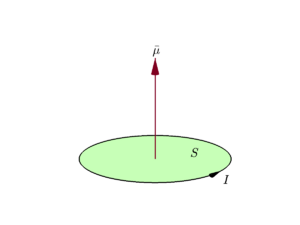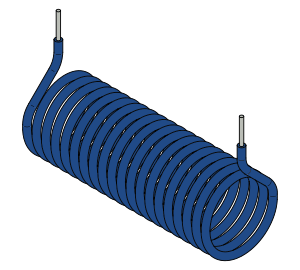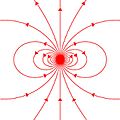Magnetic moment facts for kids
The magnetic moment is a special property of a magnet or anything that creates a magnetic field. It tells us how strong the magnet is and how much force it can put on electric currents. It also shows how much a magnetic field will try to turn the magnet.
Many things have a magnetic moment, like a simple bar magnet, a loop of electric current, tiny electrons, molecules, and even a planet!
Think of the magnetic moment as a vector. This means it has both a strength (how big it is) and a direction. The direction of a magnet's moment points from its south pole to its north pole. The magnetic field created by a magnet is also related to its magnetic moment. When we talk about "magnetic moment," we usually mean the "magnetic dipole moment." This is the main part of a magnet's field, and it gets weaker the further away you get from the object.
Contents
What is a Magnetic Moment?
Scientists use two main ways to describe magnetic moments. Older textbooks often talked about "magnetic poles," while newer ones usually explain it using "electric currents."
Magnetic Pole Idea
Imagine a magnet has two ends, a North pole and a South pole. These are like the positive and negative charges in electricity. Each pole creates a magnetic force that gets weaker with distance.
Since magnetic poles always come in pairs (you can't have a North pole without a South pole!), their forces partly cancel each other out. This canceling effect is strongest when the poles are very close, like in a short bar magnet.
The magnetic force from a bar magnet depends on two things:
- The strength of its poles.
- The distance and direction between them.
So, the magnetic moment (often called m) is defined by multiplying the pole strength (p) by the distance between the poles (l). It points from the South pole to the North pole.
Even though this idea is helpful for understanding magnets, especially strong ones like ferromagnets, it's important to remember that magnetic moments are also linked to how things spin (like angular momentum).
Current Loop Idea
Another way to think about magnetic moments is through electric currents. Imagine a flat loop of wire carrying an electric current (I). This loop has an area (S). Its magnetic moment (m) is defined as:
To find the direction of this magnetic moment, you can use the right-hand grip rule. Curl the fingers of your right hand in the direction the current is flowing around the loop. Your thumb will then point in the direction of the magnetic moment.
If the current isn't in a flat loop, or if it's spread out in space, the calculation gets a bit more complex. But the main idea is that moving electric charges create a magnetic moment. For example, a charged particle moving in a circle also creates a magnetic moment.
Magnetic Moment of a Solenoid
A solenoid is like a coil of wire with many turns. It's a common way to create a strong magnetic field. The magnetic moment of a solenoid is simply the sum of the magnetic moments of all its individual turns.
If a solenoid has N identical turns (loops) and each turn carries a current I with an area S, its total magnetic moment is:
Units of Magnetic Moment
The unit for magnetic moment isn't a basic unit in the International System of Units (SI). It can be shown in a few ways:
- From the current loop idea, where current is in amperes and area in square meters, the unit is ampere–square meters (
 ).
). - From how a magnetic field creates torque (a twisting force) on a moment, the unit is Joules per Tesla (
 ).
).
These two units are actually the same:
There are other older systems of units, like the CGS system, which have different units for magnetic moment. However, the formulas in this article are for the modern SI units.
| Particle | Magnetic dipole moment in SI units (10−27 J/T) | Spin quantum number (dimensionless) |
|---|---|---|
| electron | -9284.764 | 1/2 |
| proton | 14.106067 | 1/2 |
| neutron | -9.66236 | 1/2 |
| muon | -44.904478 | 1/2 |
| deuteron | 4.3307346 | 1 |
| triton | 15.046094 | 1/2 |
Images for kids
See also
 In Spanish: Momento magnético para niños
In Spanish: Momento magnético para niños




 of a planar current loop with area
of a planar current loop with area  and current
and current  .
.



